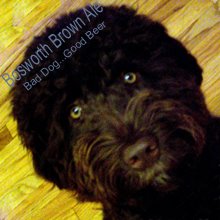
Wednesday, February 25, 2009
Pasta in Beer?

Tuesday, February 24, 2009
Persistent Head
By the way, this beer is all sterling hops. They have a distinctive flavor. I like them, but they seem a little overwhelming--I might reduce the quantity or boil time for the next batch of YSM.
What do I brew next?

I'm thinking about brewing this weekend, so I have to come up with a new brew. My basement is still frickin' cold, so another lager would be a good. I also like doing the split batches with a lager/ale, so I have some beer for sooner, and some for later.
Instead of the 11/3 gallons lager/ale strategy I used on the Johann Sebastian Bock/ Anglerman Ale and the YMM Pilsner/YSM Cream Ale, I'm thinking of reversing it. Do a small batch of a strong lager with the first runnings, and a larger batch of an ale with the second and third runnings. I'm kicking around a doppelbock/dusseldorf alt combo.
Monday, February 23, 2009
Babble Brew Off!

Monday, February 16, 2009
Johann Sebastian Bock Sampling

So Old Johann has only been lagering for two weeks, but I sneaked a sample. It's very good! F.G. is 1.023, a little higher than I wanted, so it's a little sweet, but oh that malty goodness. It's a dark copper color, with a thick creamy cream-colored head. Slightly toasty, with just a bit too much hop bitterness, which hopefully will mellow with more lager time. There is also a hint of sulfur, I hope this will dissapate with some more lagering. Clarity is excellent, crystal clear.
I definitely plan to let this lager for another 2 to 4 weeks, but I know it will be hard not to sample more while I'm waiting. I have 10 gallons of it, so a few samples won't hurt. I think this will be one to enter in contests, although the high F.G. might hurt me a little.
Friday, February 13, 2009
Friday Night Bottling
I bottled a few big bottles first, because I wanted to have some to give away, plus it seems like I get more foam when starting out, so I was going to have low fills due to foam, I would rather not have those on the small bottles I enter in competitions. Well that meant I only got nine twelve ounce bottles filled before the keg ran out. Oh well, that's enough for four competitions plus a spare bottle.
Now it's time to take Bosworth the Wonder Dog for a walk.
Wednesday, February 11, 2009
Yeast Genome Mapped!
The Mustaches are Fermenting
I still have a question about it, because I did something unconventional with these brews. The carboy of YMM was too full, and since the YSM was a small batch, I had plenty of room in its carboy. So I took about 2-3 quarts of YMM and added it to the YSM. The only problem is that the yeast had already been pitched in the YMM. So it is possible that the small amount of Munich Lager yeast from YMM has propagated in YSM and is fermenting it, instead of the American Ale Yeast that I added originally. If this is the case, it is underpitched, and it's a lager yeast fermenting at ale temperatures, so I might get some off flavors or phenolics. I would do the sniff test for sulfur compounds, (a sure sign of lager yeast activity), but I'm all stuffed up with a head cold, and I'm not sure I could smell anything. We'll see how it turns out.
Tuesday, February 10, 2009
Why Sanitize When You Can Sterilize?

Monday, February 9, 2009
Ol' Painty Can Ned


Paint strainers! I got them from Home Depot, they came in a two-pack for $2.28. They'll hold quite a bit of hops. I weighted them down with a stainless steel spoon, tied the end off, and just dropped them in the kettle. When it came time to drain the kettle, no muss, no fuss, no clogs. I highly recommend them. I know you can get something similar from the LHBS, but these were cheaper and they seem more durable.
For you non-Simpson's fans out there, the title of this post refers to Ned Flanders, Homer Simpson's neighbor. Bart spent some time at the Flanders', and Homer pressed him for some dirt on Ned. The only thing Bart could come up with was that Ned kept some old paint cans in his garage, causing Homer to exclaim tauntingly, "Ol' painty can Ned". I guess you had to see the episode.
Your Sister's Mustache

This beer is the cream ale version of "Your Mother's Mustache", which is my rice based take on the original "Your Father's Mustache".
Your Sister's Mustache (about 3 gallons)
3rd runnings from YMM's mash
1.75lbs Dry light malt extract
1 oz Sterling Hops
Wyeast American Ale
Hop Schedule
.5 oz Sterling 60 minutes
.3 oz Sterling 10 minutes
.2 oz Sterling 0 minutes
Easy, just like your sister.
O.G. 1.049
Ferment for at least a week around 65F.
Sunday, February 8, 2009
Your Mother's Mustache
Your Mother's Mustache
5lbs 6-row barley
10lbs 2-row
5lbs rice
1.15 oz Galena 13.1%AA hops
1oz Williamette 4.8% AA hops
Munich lager yeast
I did a cereal mash of the rice with 1 lb of the 6-row, basically cooking it to gelatinize the starches so they could be converted to sugar in the main mash. I should mention that I used 4 gallons of reverse-osmosis water to dilute the 4.25 gallons of tap water. I also added 4 grams of gypsum and 4 grams of CaCl to bring the mash pH down. Check your own water profile before you make any adjustments.
The mash was multi-step:
122F Protein rest 30 minutes
144F Beta rest 20 minutes
158F Alpha rest 40 minutes
I came in a little low on my protein rest (120F) and the Beta rest (141F), and I didn't want to add more hot water to bring it up, because I knew my mash tun would be completely full after the addition of the cereal mash to bring it up to the alpha rest. I compensated on the alpha rest by adding the cereal mash at a hotter temperature (185F vs 175F). Also, the alpha rest was more like 50 minutes because I forgot to heat the sparge water right away. I fell asleep at the wheel, but in my defense, I'm not used to doing cereal mashes, so I had already heated water twice, once for the main mash, and once for the cereal mash. That is all I normally do, once for an infusion mash, and once for the sparge. By the time I realized I needed to heat sparge water, I was a half hour into the alpha rest.
The hopping schedule was:
1.15 oz Galena 60 minutes
0.5 oz Williamette 10 minutes
0.5 oz Williamette 0 minutes (added at flameout)
My pre-boil gravity was 1.048 for 13 gallons, giving an efficiency of 85%, a lot higher than normal. I'm guessing this is because of the multi-step mash, plus the fact that I had a high water-to-grain ratio for the final step. Post-boil original gravity was 1.054, right in the middle of the range for this style.
I used the 3rd runnings (I batch sparged) for a separate brew, a cream ale. I added dry malt extract to the boil of that to get it up to a decent gravity. I'll post that recipe tomorrow.
Saturday, February 7, 2009
Buttery?
I got my scoresheets back from the Upper Mississippi Mashout.
- Tottenham Mild 32
- Sloppy Terry's Cream Ale 31
- Decemberfest (in mead category) 26.6
- Decemberfest (in specialty beer category) 24.5
I wasn't hoping for much from the Decemberfest, it was kind of a mistake beer, but I thought I would enter anyway to cover some categories for the Midwest Homebrewer of the Year. (You have to enter 10 different categories throughout the year to be in the running). The other two were rated near the low end of the "very good" category, and I have had beers take a 3rd or 2nd place with scores in the low 30's, but as I mentioned in another post, they failed to place.
I thought that most of the score sheets came back with fair assessments of the beers, with the exception of one on the Tottenham mild. One of the judges (out of 3) decided that it had a "diacetyl problem", causing an overpowering buttery flavor. He gave it a 29, the other judges rated it 32 and 34. I'm not sure where this opinion came from. I taste no diacetyl in the beer at all, and neither of the other judges mentioned diacetyl or buttery at all on their score sheets. Also interestingly, one judge said the beer was too carbonated, and another said it was not carbonated enough. Strange.
I will enter the Tottenham in another competition; I still think it's good enough to win. Maybe in the next contest I won't get a judge with butter on his brain.
Tuesday, February 3, 2009
Did I say kegerator photos?
Monday, February 2, 2009
Superbowl Sunday! Now in 3D!

So what's Superbowl Sunday without a Superbowl party? We hosted one here at Casa Brew, of course with homebrews on tap. So what was on tap?
- Superbowl Stout--brewed on New Year's Day specifically for the Superbowl. A sweet stout, full of creamy dark chocolately goodness. Overheard from one of the imbibers at the party, "it goes great with the football cookies".
- Beat the Heat Wheat--an American wheat ale, better suited for a hot August afternoon, yet still crisp and refreshing on a cold February eve.
- Anglerman Ale--American hops, English yeast, and German malt. An amber ale, made from the same ingredients as a bock, but with ale yeast. Malty, full-bodied, hearty ale which paired well with the chili and lasagna. You've heard of comfort food? Well this is comfort beer.
- Tottenham Mild--Named after the football team. Yes the soccer type of football. An English Brown ale, mildly hopped and traditionally a "session beer". Although this one came in a little stronger than intended. Call it an imperial mild.
The party was a rousing success, and the game was exciting to the very end. Final score: Superbowl Stout 5 gallons, Beat the Heat Wheat 2 gallons (all I had on tap), Anglerman Ale 3 gallons (also all I had on tap), and Tottenham Mild 4 gallons.
Sunday, February 1, 2009
"How's your bock doing?"
Well Ben, and the four other readers of this blog, my bock is doing just fine. I brought it upstairs to the brew closet yesterday for a diacetyl rest. Probably a little late for that, since it has been sitting in primary for 30 days, but who knows, maybe there's a little fermentation to finish out at higher temps. I roused the yeast just by jostling the carboy as I carried it up the stairs. Note to self, find a way to not carry 11 gallons of beer in heavy glass carboys up stairs.
Once I free up some kegs, probably today at my Superbowl party, I'll rack it to the kegs, and lager it in the kegerator for 6 weeks. That means my Johann Sebastian Bock will be ready in time for the birthdate of its namesake.







